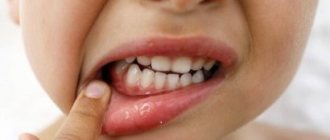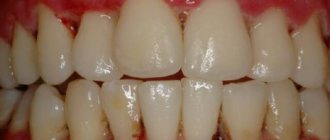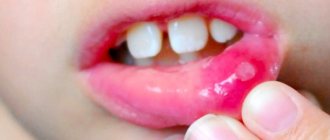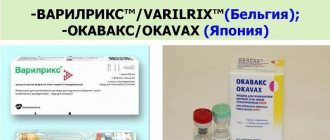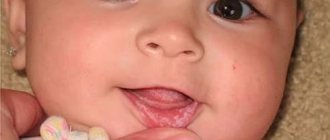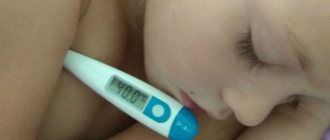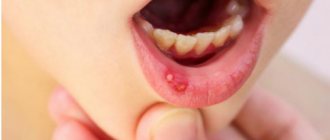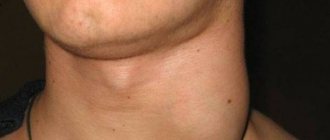Gingivitis is a periodontal disease accompanied by inflammation of the marginal part of the gums (tissue swelling, pronounced hyperemia). In children, the occurrence and development of the disease is associated with the active occurrence of biological processes in periodontal tissues: teething, bite formation, and root formation. During puberty, in most cases, gingivitis is a consequence of hormonal changes in the body.
Important. The disease is common, occurring in approximately 2% of children aged 2-4 years; in older children, the diagnosis rate is much higher.
Causes of gingivitis in children
80-90% of cases of the disease in children are associated with the accumulation of dental plaque, which is an ideal environment for the proliferation of pathogenic microflora. The more dental plaque there is and the older it is, the greater the number of bacteria that develop in it. One day without oral hygiene is enough for the first signs of the disease to appear. Treatment of gingivitis in this case comes down to professional hygiene - removing stones and plaque.
Predisposing factors also include uneven load on the child’s periodontal complex. This may be due to an incorrect bite, crowded teeth, tooth decay or poorly fitting fillings. The appearance of gingivitis in children can be caused by injury to the gums (for example, while brushing teeth), or as a result of burns from hot food.
In some patients, acute gingivitis occurs against the background of teething or changing teeth. The gums become inflamed at this time, acquiring a characteristic bright red color. Puberty is also a risk factor.
In some cases, gingivitis can develop against the background of past infections or systemic diseases that weaken the immune system. Diabetes mellitus, heart disease and thyroid disease predispose to the onset of the disease.
Periodontitis and gum disease
Ignoring carious formations leads to the development of pulpitis, which turns into periodontitis. During periods of exacerbation of the disease, you may notice swelling of the gums, and cysts with purulent contents appear.
Symptoms of gingivitis in children
Common symptoms of gingivitis in children include swelling of the gums, congestion (fullness of the blood vessels with blood), and pain in the mouth. In the advanced form, fever and general malaise are associated. Also a common feature for all varieties is poor oral hygiene.
Quite often, stomatitis (gingivostomatitis) is associated with gingivitis. In this case, not only the gums suffer, but also the entire oral mucosa. The child experiences constant pain, itching, burning, and becomes capricious and uncontrollable.
Viral gingivitis is especially dangerous against the background of a herpes infection, quickly turning into an ulcerative form. Young children are most susceptible to it. A one-year-old child, due to his age, pulls all objects into his mouth, thereby creating a favorable environment for the development of pathogenic bacteria.
Plasma cell gingivitis (allergic) –
With plasma cell gingivitis, we see that the gum has a bright red color, as a rule, it is swollen and increased in size (in the initial stages and a limited volume of the lesion - the volume of the gum may not be increased). The process consists of plasma cell infiltration of the gum, namely its subepithelial layer. Infiltration of the gums by plasma cells occurs as a hypersensitivity reaction to certain antigens - especially often to various flavors or spices.
Plasma cell gingivitis in a child, teenager -
Thus, an allergic reaction can occur to the components of chewing gum, toothpastes, and lollipops. Plasma cell gingivitis often develops in children due to cinnamon and other flavorings contained in baked goods and confectionery products, as well as various drinks. Often the cause can be absolutely any product containing natural herbal ingredients.
Treatment should consist of identifying and eliminating the causative factor (allergen). In case of a generalized, pronounced process and the formation of periodontal pockets, local anti-inflammatory treatment is additionally carried out in combination with systemic antibacterial therapy with azithromycin. Early correct diagnosis is very important, because plasmatic gingivitis has similar clinical manifestations in the oral cavity, which can be observed with leukemia, HIV infection, discoid lupus erythematosus, lichen planus, and desquamative gingivitis.
Types of gingivitis
The disease can progress differently, depending on the type of gingivitis. Treatment is prescribed by a doctor individually in each specific case.
Important. The acute form of the disease is much more common in children. The chronic form occurs in the absence of treatment.
Classification
The disease is classified according to several criteria:
- zone of distribution - local (one interdental papilla is inflamed) or generalized (most of the gum is inflamed) gingivitis;
- nature of the course - acute or chronic stage;
- the degree of change in the mucous membrane of the gums - catarrhal, ulcerative, hypertrophic, atrophic, marginal, desquamative.
According to the severity of the disease, three forms are distinguished - mild (damage to one or two interdental papillae), moderate (inflammation of the gum edge), severe (damage to most of the gum).
Catarrhal
Acute catarrhal gingivitis is most often diagnosed during teething or changing teeth, as well as against the background of previous infectious diseases.
Characteristic features:
- severe redness and swelling of the affected areas;
- discomfort in the gums, pain, itching, bleeding of the gums when brushing teeth or eating;
- bad breath;
- low-grade fever.
There is a feeling of malaise, but the general condition is not cause for concern.
Marginal
It usually occurs in childhood and indicates poor oral hygiene. It goes away immediately in a chronic form, another name for the disease is “dirty” gingivitis. It manifests itself in bleeding gums, usually when brushing your teeth. The marginal tissues are swollen, hyperemic, with a cyanotic tint. Treatment consists of removing plaque and following oral hygiene rules.
Desquamative
The main feature of desquamative gingivitis is epithelial sloughing. The affected areas are also distinguished by increased redness in the form of individual spots. In the initial stage, the disease does not cause concern, but later, in the absence of treatment, the mucous membrane becomes loose, pain and burning in the gums appear, and erythema spots grow. When neglected, blisters with yellowish contents appear in place of the spots, then ulcers form in place of the blisters. At the same time, sleep is disturbed, headaches and irritability appear.
Important. Desquamative gingivitis occurs cyclically with sudden exacerbation without provoking factors. Remission is long-term, up to two years.
Hypertrophic
The second name is hyperplastic. The disease is typical for prepubertal and pubertal age and is associated with the influence of sex hormones on gum tissue at this particular age. In the fibrous form, there is an overgrowth of the papillae, the gums are greatly enlarged and partially cover the teeth. The edematous form is more severe - the gums are enlarged and hyperemic. When brushing your teeth and chewing food, the pain and bleeding noticeably intensify.
A dental examination reveals severe gum overgrowth, looseness and swelling of the gingival papillae, and the presence of false gum pockets. Also, a distinctive feature of hypertrophic gingivitis is a significant amount of plaque on the teeth.
Ulcerative
The ulcerative form is the next stage of catarrhal gingivitis against the background of decreased immunity after influenza, acute respiratory viral infections, infectious diseases, and herpetic stomatitis. Another reason is hypothermia.
Characteristic symptoms:
- hyperemia, swelling, bleeding gums;
- the appearance of ulcers;
- general weakness, low-grade fever;
- bluish tint near the gums.
In the absence of adequate therapy, the disease passes into the ulcerative-necrotic stage - the ulcers are covered with a gray-green coating, a putrid odor from the mouth appears, and saliva becomes viscous. Sleep and appetite disturbances are observed, the child becomes capricious.
Atrophic
In most cases, the disease is chronic and is detected during examination by a dentist. It is observed in case of improper filling of teeth, in the presence of congenital defects of the frenulum of the tongue, or in case of malocclusion.
Symptoms – not clearly expressed:
- slight bleeding gums;
- exposure of tooth roots;
- reduction in gum volume.
In the initial stage, there are no inflammatory signs or pain, the gums are not hyperemic. Then, with the gradual exposure of the roots of the teeth, discomfort and pain appear when eating hot or cold food. In the absence of treatment, progressive dystrophic changes in the gingival margin are observed.
Treatment
Treatment for childhood gingivitis is practically no different from how adults are treated. Only medications used for them are softer and more gentle. Treatment begins with professional cleaning of hard deposits and plaque of tooth enamel - mechanical or ultrasonic.
If caries is detected during the examination, then therapeutic treatment is carried out. Gingivitis is then treated with medications with antiseptic and anti-inflammatory properties. Measures are taken to eliminate detected pathologies (bite, frenulum, etc. are corrected).
Ointments and gels are considered effective for children under 4 years of age. For example, Cholisal ointment has analgesic and anti-inflammatory properties, which makes it possible to prescribe it to alleviate the patient’s condition, especially when baby or permanent teeth are cutting. Ointments and gels are applied directly to the inflamed area.
Antibiotics in tablets or in the form of injections are prescribed to children in difficult cases (the presence of infections of bacterial origin in the body). At elevated temperatures, rinses, drinking plenty of fluids, antioxidants, antipyretic drugs for children, and taking vitamins are prescribed.
Prevention measures should include regular visits to the pediatric dentist, training in oral care rules, and parental monitoring of the development of hygiene skills.
How to treat gingivitis in children
Gingivitis is a disease with a favorable prognosis. Accurate adherence to the doctor’s recommendations makes it possible to fully recover and eliminate future relapses.
Treatment always begins with sanitation of the oral cavity. Removing tartar and soft plaque is mandatory, since deposits are a source of infection. For young children, cleansing is carried out using special brushes, for older children (after 10 years) - using ultrasound. After cleansing, the doctor prescribes rinsing with anti-inflammatory agents twice a day (in pharmaceutical form or decoctions of chamomile, sage, mint, eucalyptus).
Important. Dear parents. It is not possible to cure the disease with folk remedies alone. By neglecting this rule, you risk aggravating your child's condition.
When treating gingivitis, the doctor uses an integrated approach, taking into account the individual characteristics of the child. Carious cavities are removed, and fillings with overhanging edges or poor polishing are replaced. If there is a congenital malocclusion or tongue frenulum, the necessary manipulations are performed. At a certain stage, consultations with narrow specialists may be required - a dental surgeon, an orthopedic dentist, a therapist, an endocrinologist, a cardiologist.
If necessary, the doctor prescribes intraoral electrophoresis, laser therapy, massage, and ultraviolet radiation. At an advanced stage of the disease, antibiotics are necessary. In severe cases, when conservative therapy is unsuccessful, surgery may be required.
The most important role in the treatment of gingivitis in children is played by vitamin therapy and proper nutrition. It is necessary to create a diet in such a way that you use foods high in vitamins for cooking.
Important. During treatment, you need to ensure that the food is ground or soft. Parents are required to ensure that the eating process causes as little discomfort as possible.
Diagnostics
The diagnosis of gingivitis is established by a pediatric dentist or periodontist based on an examination of the oral cavity, due to the characteristic clinic. All forms of pathology have characteristic signs.
They are:
- the presence of soft deposits or tartar;
- the presence of gum inflammation;
- there are no gum pockets;
- dentogingival connections are preserved.
X-rays are performed to confirm the diagnosis. Changes in the jaws are not detected. Numerous concomitant diseases are detected (malocclusions, caries, abnormal attachment of the frenulum of the lips and tongue), filling defects. To find the causes of the pathology, consultations with a cardiologist, endocrinologist, or therapist are prescribed.
Medicines for gingivitis
The medications your child needs are prescribed only by a doctor, based on the clinical picture of the disease and the individual condition of your child. Self-medication in this case is unacceptable, as it can lead to significant complications, including osteoporosis of bone tissue.
What to smear
Gels and ointments are applied after rinsing the mouth. The surfaces are pre-dried with a cotton swab or gauze.
Holisal.
The gel has a good anti-inflammatory and analgesic effect. Apply three times a day to the affected areas of the gums.
Apident active.
An ointment based on natural ingredients that quickly relieves pain and inflammation. The composition is applied to the inflamed areas and rubbed in with gentle circular movements.
Solcoseryl.
Used to heal bleeding areas, the gel is applied to both sides of the gums. Use as prescribed by a doctor.
Asepta gel.
Mainly prescribed for the treatment of chronic gingivitis. The drug relieves inflammation, pain, and itching well. Apply 2-3 times a day depending on the severity of the condition.
How to rinse
Important. Alcohol tinctures should not be used for rinsing, as their use will lead to even greater irritation.
Rinsing is mandatory when carrying out anti-inflammatory therapy. Carry out after each meal and additionally throughout the day. For young children, parents apply applications using cotton swabs soaked in solutions. In severe cases, treatment of the oral cavity and gums is carried out in the dental office.
For rinsing the following is prescribed:
- Chlorhexidine 0.05%.
Use after every meal. Rinse your mouth vigorously for 30 seconds. - Furacilin.
Use a ready-made 0.02% rinse aid or dissolve one tablet in a glass of boiled water. The drug disinfects the oral cavity well. - Furamistin 0.01%.
It has a powerful antibacterial effect and is used after meals. - Herbal infusions.
Prepare at home in accordance with doctor's recommendations.
Important. Before using solutions, rinse your mouth with clean water to remove any remaining food.
Antibiotics
In the chronic stage and in severe forms of the disease (ulcerative, ulcerative-necrotic), as well as in cases of high risk of complications, antibiotics are prescribed. The doctor selects the drug and dosage individually.
Peculiarities
Gingivitis is extremely common in childhood and adolescence, as children are most susceptible to gingivitis. This is due to the increased susceptibility of periodontal disease in children.
The periodontium is a “structure” of various tissues that holds the tooth and also supplies it with necessary substances through an extensive network of blood vessels.
The incidence of gingivitis reaches its peak with the onset of middle school age, when the accelerated growth of periodontal tissue is superimposed on the “hormonal explosion” characteristic of adolescents.
Gingivitis is not uncommon in very young children, 1 year of age or younger. This is understandable, because one of the main factors in the occurrence of gingivitis is gum trauma, which is what happens during teething. And to these natural injuries is added the underdevelopment of the immune system and the weak saturation of the oral cavity of a small child with beneficial microflora.
Sometimes you can find gingivitis even in infants. Parents are advised to immediately contact a pediatric dentist if they detect any suspicious symptoms at such a tender age.
An additional risk factor may be a short frenulum of the lip, which interferes with proper gum hygiene and contributes to the accumulation of food debris. In most cases, the labial frenulum stretches on its own, but if this does not happen before the child is 2 years old, surgical resection is performed as prescribed by the doctor.
Folk remedies
Traditional methods are based on the specific properties of plants, decoctions of which have a good anti-inflammatory effect.
Sage.
Pour two tablespoons of the herb into 0.5 liters of boiling water, boil for 10-15 minutes, leave for an hour. Rinse your mouth 2-3 times a day. The decoction relieves inflammation well and reduces bleeding gums.
Pine needles.
Pour 1-2 tablespoons of needles into a glass of hot water, bring to a boil, leave for 40 minutes. Use 3-4 times a day. The infusion has a strong antimicrobial effect.
Aloe.
Chew peeled and well-washed leaves several times a day.
Pharmaceutical camomile.
Take chamomile flowers and linden flowers in equal proportions. Pour boiling water over tablespoons of the mixture, boil for 20 minutes, and let steep for half an hour. The infusion has a pronounced anti-inflammatory effect. Apply three times a day.
Herbal collection
(mix oregano, St. John's wort, peppermint in a ratio of 1:1:2). Pour three tablespoons of the mixture into 1.5 cups of boiling water and simmer for another 30 minutes. Leave for two hours, rinse three times a day. The decoction helps relieve inflammation and pain, eliminates bleeding and bad breath.
Prevention
The main means of preventing gingivitis, as well as other dental diseases, is oral hygiene. From a very early age, teach your child to brush their teeth for at least 10-15 minutes, making sure to pay attention to the inside of the teeth. Buy your child a therapeutic toothpaste and make sure he brushes his teeth correctly. To eliminate stubborn plaque, you can use a brush with moderately hard bristles. After brushing, teeth should be rinsed thoroughly.
Teach your child to use dental floss to remove food debris from between the teeth. But keep in mind that dental floss can also injure the gums if used incorrectly, so it is not recommended to use dental floss for a child under 3 years of age.
Modern dentistry does not encourage the use of toothpicks for dental care, since their use risks not only injuring the gums, but also causing infection. Give preference to dental floss.
If tartar has formed in your child’s mouth, then a visit to the dentist is essential. The doctor will remove tartar in the most gentle way possible.
Diagnostics: how to find out that a child has gingivitis
The doctor makes a diagnosis based on an examination of the oral cavity, complaints from the patient (or his parents), as well as functional tests performed to determine the amount of microbial plaque and the bleeding index.
To avoid errors in diagnosis, the doctor prescribes an X-ray examination of the teeth. The main difference between gingivitis and other diseases is that the inflammatory process affects only the gums. Bone tissue and muscle ligaments remain unchanged.
Author: Maria Kozodoeva Dentist-therapist, periodontist. Work experience more than 11 years.
The information is for reference only. Before treatment, consultation with a doctor is necessary.
Gingivitis against the background of herpetic stomatitis –
Very often, with viral herpetic stomatitis, concomitant acute gingivitis occurs. In this case, the periodontal papillae and the marginal part of the gums increase due to swelling and become bright red. Read more about gum inflammation due to stomatitis in the article: “Treatment of various forms of stomatitis in children.” We hope that our article on the topic: Gingivitis in children treatment was useful to you!
Sources:
1. Dental education of the author of the article, 2. Based on personal experience as a dentist, periodontist, 3. The European Academy of Paediatric Dentistry (EU), 4. National Library of Medicine (USA), 5. “Pediatric therapeutic dentistry. National leadership" (Leontyev V.K.).
Gum atrophy
A rather unique and rare disease - gum atrophy or exposing atrophic gingivitis manifests itself as itching in the area of 2, less often 4 and 6 symmetrically located milk teeth. A child experiencing discomfort constantly rubs the area of inflammation. At night, the itching usually intensifies.
The interdental papillae and other areas of the gums do not change in any way during gingival atrophy. Slight deposits of tartar are often observed on the unprotected root surface.
The manifestation of itching can be a consequence of measles or influenza, despite the fact that in most young patients such a relationship is not observed. The process of teething is also one of the factors causing itching in infants.
Preventive actions
The best prevention of inflammation of the mucous membrane is daily and high-quality hygiene from an early age and proper nutrition.
Hygiene
The concept of “quality hygiene” includes brushing your teeth at least twice: in the morning and in the evening, in conjunction with cleaning the palate and tongue.
Parents should take a very responsible approach to hygiene from the day the first tooth appears. And after he grows up a little, learn the rules of brushing his teeth: regularly and efficiently. The toothbrush and toothpaste should be selected according to the age of the small patient.
Nutrition
In addition to hygiene, parents need to approach the diet wisely: it should be balanced and include vitamins and minerals. Sweets and carbonated drinks should be consumed by the child in limited quantities. In addition, after finishing eating sweets, the baby should rinse his mouth with water and, if possible, brush his teeth. Note that a diet that promotes the proper development of a growing body includes nutritious and timely meals. Snacking and disordered eating should be kept to a minimum.
Contrary to popular belief, the main dental problems in children are not related to the teeth, but to the gums. It is not surprising, because a child’s temporary baby teeth completely change over the years, but the gums remain with the person forever. One of the most common gum diseases is gingivitis - inflammatory damage to the mucous membranes of the gums.
The damage and changes in oral tissues caused by gingivitis are not irreversible. The main thing for the child’s parents is to identify the presence of a problem in a timely manner and in no case allow the course of the disease to take its course, or miss the time to start treatment.
A distinctive feature of gingivitis is that inflammation in this disease does not affect the tissue of the tooth itself, the periosteum, or the connection between the gum and tooth.
Causes
The main cause of childhood gingivitis is almost always an insufficient level of hygiene and prevention of oral diseases.
The main cause of gingivitis in children is insufficient attention to oral hygiene.
Parents often make the mistake of teaching young children to brush their teeth, but not supervising this process in the future. A child, not understanding the importance of oral hygiene, can turn the process of brushing teeth into a fun but useless game. The result in the form of plaque is usually visible, or rather, on the teeth and gums.
Plaque on children's teeth serves as an excellent food source for microorganisms, including pathogens. As the colony of microbes grows, it causes a response from the body—inflammation occurs.
Inflammation is a visible manifestation of the body's protective immune mechanisms in response to the harmful effects of environmental factors.
Although inflammation is a natural reaction of the body struggling with an undesirable effect, this fight does not pass without a trace - the body consumes internal resources, as a result of which the inflamed tissue is gradually destroyed.
The following factors also contribute to gingivitis in children:
- unbalanced diet, lack of important minerals and vitamins, especially vitamin C;
- injuries to the mucous membrane of the gums due to malocclusion, chewing hard food, burns from hot food or drink;
- viral infections;
- diabetes;
- hereditary predisposition.
Peculiarities
Gingivitis is extremely common in childhood and adolescence, as children are most susceptible to gingivitis. This is due to the increased susceptibility of periodontal disease in children.
The periodontium is a “structure” of various tissues that holds the tooth and also supplies it with necessary substances through an extensive network of blood vessels.
The incidence of gingivitis reaches its peak with the onset of middle school age, when the accelerated growth of periodontal tissue is superimposed on the “hormonal explosion” characteristic of adolescents.
Gingivitis is not uncommon in very young children, 1 year of age or younger. This is understandable, because one of the main factors in the occurrence of gingivitis is gum trauma, which is what happens during teething. And to these natural injuries is added the underdevelopment of the immune system and the weak saturation of the oral cavity of a small child with beneficial microflora.
Sometimes you can find gingivitis even in infants. Parents are advised to immediately contact a pediatric dentist if they detect any suspicious symptoms at such a tender age.
An additional risk factor may be a short frenulum of the lip, which interferes with proper gum hygiene and contributes to the accumulation of food debris. In most cases, the labial frenulum stretches on its own, but if this does not happen before the child is 2 years old, surgical resection is performed as prescribed by the doctor.
Symptoms and classification
In order to prevent the disease from developing and begin treatment as soon as possible, you need to correctly and timely recognize the symptoms of the disease. The symptoms of gingivitis directly depend on the stage in which the disease is located.
- Catarrhal is the mildest and most common type of disease. This acute stage is characterized by redness and swelling of the gum edges, itching, burning, and the formation of characteristic dental deposits. An unpleasant odor from the mouth is noticeable. An older child may complain of an unpleasant taste in the mouth. The famous pediatrician Evgeniy Komarovsky claims that catarrhal gingivitis and stomatitis in children often accompany diseases caused by herpetic and viral infections.
- Simple marginal is a chronic, sluggish type of catarrhal gingivitis. The symptoms are similar, but less pronounced. Noticeable pain with this variety is rare, and the itching can be quite severe, which is why this disease often goes unnoticed in young children - it is simply confused with natural itching during teething.
- Desquamative is manifested by profuse redness and peeling of the gum mucosa.
- Hyperplastic most often occurs with hormonal origins of the disease, which is typical for adolescents. This type of disease is distinguished by noticeable inflammation of the protrusions of the gums between the teeth - the so-called periodontal papillae. When swollen, the papillae form sinuses at the base of the tooth, which are often filled with foul-smelling pus. The gums bleed.
- Hypertrophic is a severe chronic form of hyperplastic gingivitis. The swelling of the inflamed periodontal papillae in this form of the disease is so pronounced that the crown of the tooth can be significantly (sometimes completely) hidden in the swollen gum.
- Ulcerative necrotic is a severe form of the disease. The child experiences severe burning pain, open bleeding ulcers form at the base of the teeth, and the bases of the teeth are partially exposed. Signs of general malaise may appear - weakness, nausea, fever.
- Atrophic - the most severe stage of inflammation of the mucous membrane of the gums, the gum tissue becomes noticeably thinner, and the bases of the teeth are greatly exposed. Bleeding and discharge of pus are profuse, severe pain requires medication relief.
If left untreated, childhood gingivitis progresses to the stage of deep periodontal damage - periodontal disease, which is fraught with the loss of a significant part of the dentition.
Treatment of gingivitis in children
Treatment in the early stages
Gingivitis in the early, not advanced stages (catarrhal and simple marginal gingivitis) can be easily treated on your own at home.
You should start by alleviating the child’s condition. Anesthetics, in particular various lidocaine-based drugs, will help relieve pain. For the treatment of children, it is recommended to use the lidocaine-containing drug “Kalgel”. This gel-like product is approved for use even for the youngest patients, even with gingivitis in a one-year-old child. "Kalgel" can be used, among other things, for teething in infants.
The use of bactericidal ointments and rinses, such as:
- Propsol;
- Eludril;
- Chlorhexidine;
- Romazulan.
Also, one of the most commonly used medications for gingivitis in a child is Cholisal gel. This drug, in addition to being anti-inflammatory, also has a bactericidal effect. In any case, before using vitamin supplements and medications, especially when treating gingivitis in infants, it is better to consult with your doctor.
It is also important to pay attention to the nutrition of children: food for gingivitis should not be too cold or hot, sour or salty. The main task during this period is to minimize the impact of irritating factors on the oral cavity.
After relieving inflammation and reducing pain, therapy is carried out aimed at destroying pathogens. For this purpose, antibiotic drugs are widely used, for example, Amoxicillin, Metronidzole, Erythromycin.
After the use of antibiotic drugs, restorative therapy necessarily includes a course of probiotic drugs that help restore the normal bacterial background and replenish beneficial microflora.
Treatment of hyperplastic and hypertrophic forms
Severe forms of gingivitis can only be treated in specialized medical institutions. Treatment of hyperplastic gingivitis and its severe form, hypertrophic gingivitis, in addition to an anti-inflammatory course and antibacterial measures, may include removal of swollen gum tissue. The following methods are used for this:
- Freezing . Sclerosing agents are injected into the gum tissue: dextrose solution or calcium chloride. The introduction of these drugs causes hardening of the periodontal papillae and the cessation of pathological tissue growth.
- Cauterization with electric current . It allows you not only to stop the growth of edema in a large area of tissue, but also to stop bleeding. Cauterization is carried out using the method of diathermocoagulation - exposing the tissue to a current of 3-5 Amps of high frequency. The procedure is painful and is performed under local anesthesia, so it is not recommended for children under five years of age.
- Chemical cauterization . A mixture of sulfuric acid solution and ether is applied to the dried surface of the gum with a cotton swab.
- Gum trimming (gingivectomy). It is used in especially severe cases, when healing a child’s oral cavity without surgery is no longer possible. The operation is performed under general anesthesia and, as a rule, occurs without complications. Gingivectomy must be combined with freezing or cauterization of the gums, otherwise the pathological growth may continue, and after some time the truncation will have to be performed again.
Treatment of ulcerative necrotic and atrophic gingivitis
The sooner a child suffering from ulcerative or atrophic gingivitis gets to a dentist, the better. At home, the child should be given bed rest and rest, as general malaise may be observed, accompanied by an increase in temperature.
In case of pronounced bleeding of the gums, when gingivitis has reached the ulcerative or atrophic stage, it is not recommended to use toothbrushes with hard bristles. In severe cases, you will have to refrain from brushing your teeth altogether, limiting yourself to rinsing your teeth with special balms.
Antiviral and anti-inflammatory therapy for these forms is similar to similar procedures for marginal and catarrhal gingivitis. Bleeding is stopped with the help of spot application (application) of hydrogen peroxide.
Necrotic (dead) tissue areas around ulcers are removed surgically or conservatively using the method of necrolysis - non-surgical resorption. Necrolysis of dead tissue is carried out by applying the sublimated enzyme trypsin dissolved in sodium chloride to the affected areas.
After the inflammation has stopped and the ulcers have healed, the child may need gingivoplasty - restoration of lost areas of gum by transferring tissue flaps from other areas of the periodontium.
Folk remedies
A serious help in the treatment of gingivitis will be turning to traditional medicine and homeopathy. To prevent oral diseases and strengthen teeth, decoctions of oak bark, sage, St. John's wort, and motherwort have long been used.
To treat inflammatory processes in a child, the use of alcohol-based infusions, as well as an alcohol solution of iodine, is not allowed!
Traditional recipes:
- St. John's wort oil. The product is prepared independently from dry leaves of St. John's wort, which can be purchased at the pharmacy. A tablespoon of crushed leaves is poured with half a glass of refined vegetable oil and left to infuse overnight. Lubricate inflamed gums with St. John's wort oil three times a day.
- A mixture of sage and eucalyptus leaves in equal proportions is poured with boiling water at the rate of a teaspoon of sage and eucalyptus per glass of boiling water. Leave for 24 hours and strain. Take a tablespoon before meals.
- Dilute 3-4 grams of mumiyo in a glass of warm water and use it to rinse your mouth before bed.
- Another way to use mumiyo: dilute the same amount (3-4 grams) in a glass of warm low-fat kefir (mix thoroughly!). Keep in mouth for two to three minutes, then swallow.
Prevention
The main means of preventing gingivitis, as well as other dental diseases, is oral hygiene. From a very early age, teach your child to brush their teeth for at least 10-15 minutes, making sure to pay attention to the inside of the teeth. Buy your child a therapeutic toothpaste and make sure he brushes his teeth correctly. To eliminate stubborn plaque, you can use a brush with moderately hard bristles. After brushing, teeth should be rinsed thoroughly.
Teach your child to use dental floss to remove food debris from between the teeth. But keep in mind that dental floss can also injure the gums if used incorrectly, so it is not recommended to use dental floss for a child under 3 years of age.
Modern dentistry does not encourage the use of toothpicks for dental care, since their use risks not only injuring the gums, but also causing infection. Give preference to dental floss.
If tartar has formed in your child’s mouth, then a visit to the dentist is essential. The doctor will remove tartar in the most gentle way possible.


